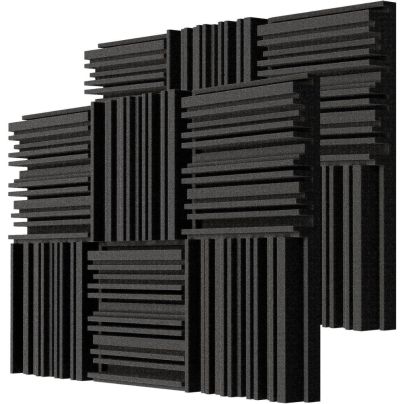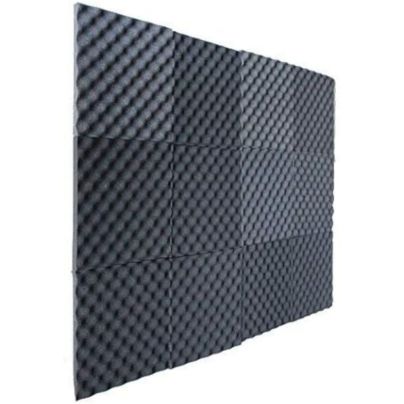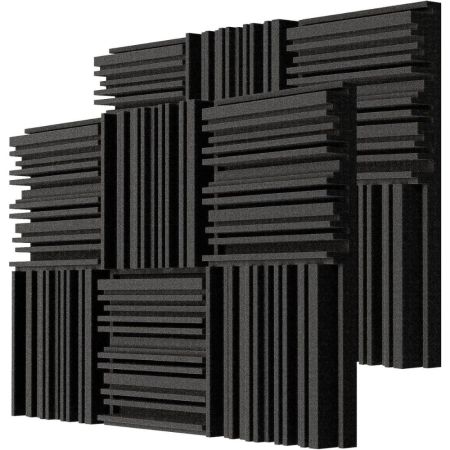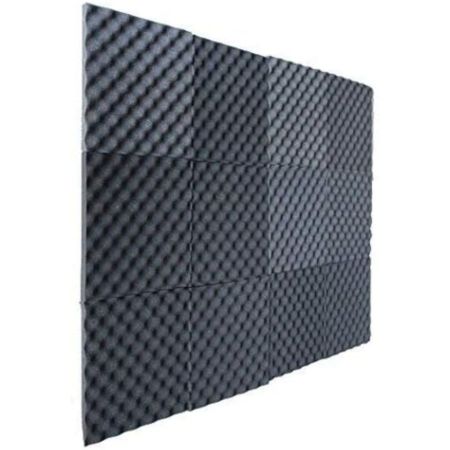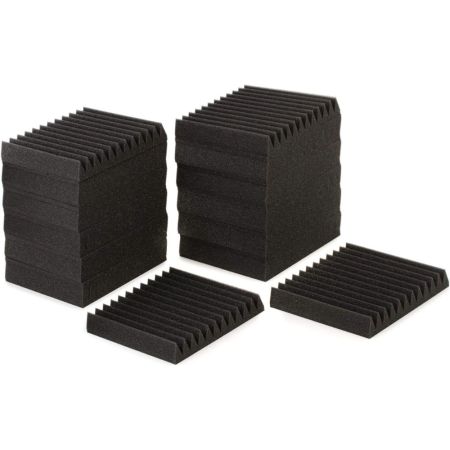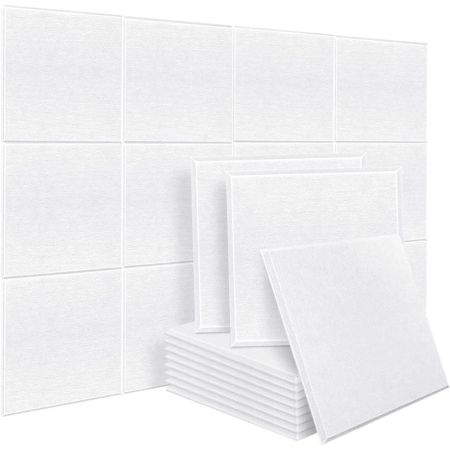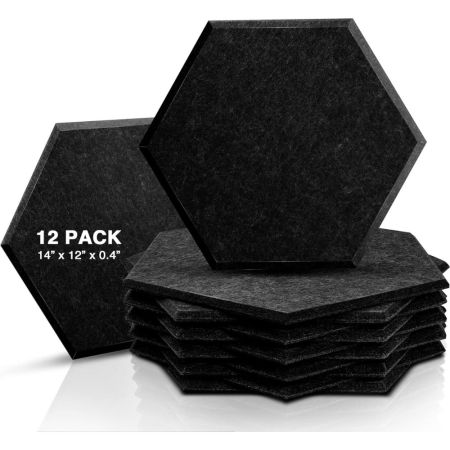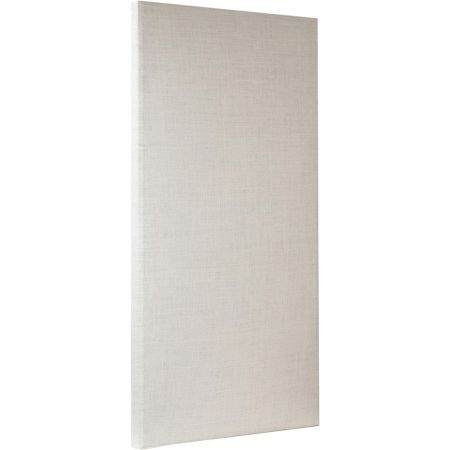We may earn revenue from the products available on this page and participate in affiliate programs. Learn More ›
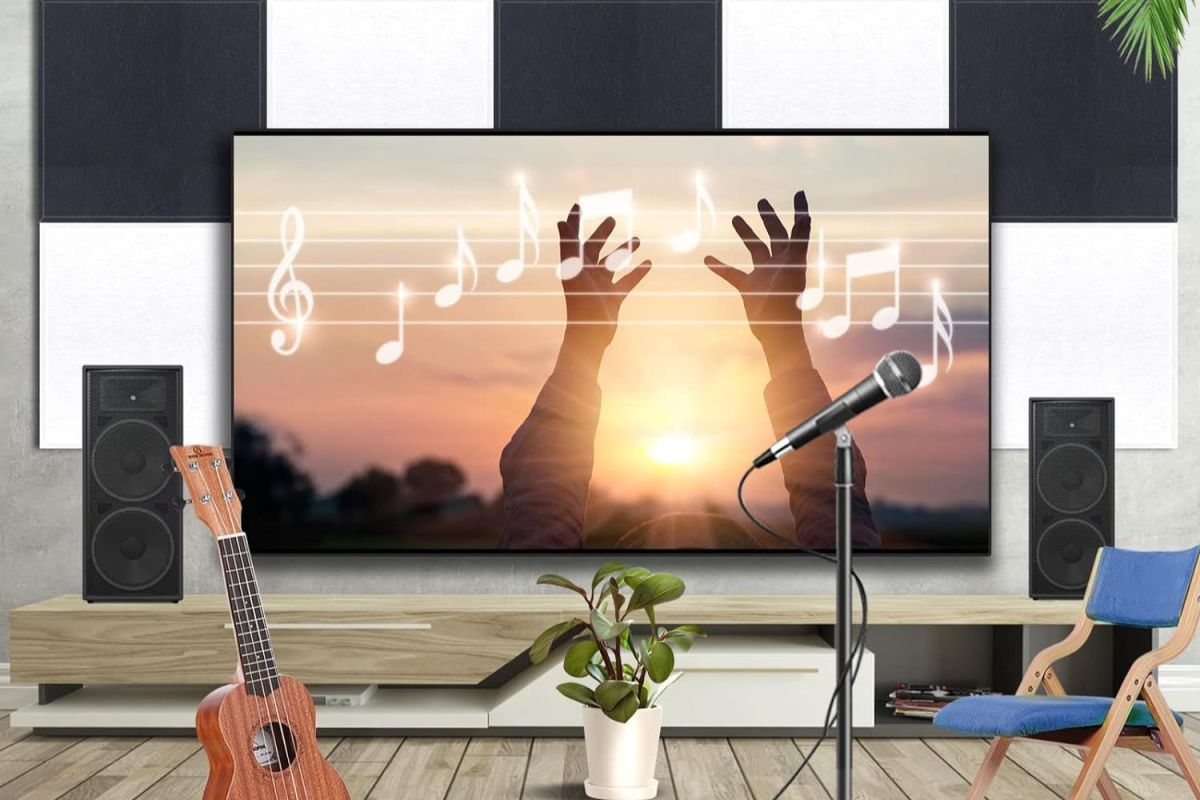
Soundproofing panels are not just for recording studios and theaters. They can also successfully manage noise in homes and offices, making them more peaceful spaces for work or relaxation. Many are affordable and easy to install, and some provide a decorative aesthetic.
The challenge is choosing the right ones, and for those new to technical aspects such as noise reduction coefficients, the jargon can be confusing. In this article, we explain what potential buyers need to know in straightforward language. After looking at over 40 different products, we assembled this list of the best soundproofing panels for a variety of purposes.
- BEST OVERALL: TroyStudio Thick Acoustic Foam Panels
- BEST BANG FOR THE BUCK: Izo Egg Crate Foam Acoustic Panels
- BEST DESIGN: Bubos Decorative Art Acoustic Panels
- BEST FOR RECORDINGS: Auralex Studiofoam Wedgies
- BEST FOR OFFICES: Dekiru Soundproofing Insulation Panels
- BEST COLOR RANGE: Sonic Acoustics Hexagon Soundproofing Panels
- BEST LARGE PANEL: ATS Acoustics Soundproofing Panel

How We Chose the Best Soundproofing Panels
Noise can be managed in different ways. In living spaces and offices, absorbing as much sound as possible is the goal. In home theaters, recording studios, and auditoriums, the goal is to shape and redirect the sound to create a particular atmosphere. To provide solutions for as many different people as possible, we chose top soundproofing panels from a variety of different categories.
Noise reduction coefficient (NRC) is a key feature that we discuss in more detail below, and it’s represented by a rating that indicates how efficient a panel is at absorbing sound. In addition, we considered aesthetics, ease of installation, and cost.
We also sought some expert input. Joe Cuschieri, executive director of the Institute of Noise Control Engineering, says, “When dealing with noise or sound, there are two considerations: transmission and absorption. If the objective is to improve the sound quality in the room, then installation of sound absorption materials will reduce reverberation and improve the acoustics.” However, he goes on to say that if the problem is intrusion, meaning sound from other areas, “This type of noise improvement will be more complex, and a professional may be required to modify a wall partition.”
Our Top Picks
According to our research, the following products are the best soundproofing panels available right now. We have given each product a category so that potential buyers can easily identify those that are most suitable for their specific needs.
Best Overall
TroyStudio Thick Acoustic Foam Panels
See ItProduct Specs
- NRC: 0.8
- Size: 12 inches tall by 12 inches wide by 2 inches thick
- Installation: Simple
Pros
- Excellent general-purpose panel for sound absorption in offices, homes, and recording spaces
- Dense foam and 3D shape cancel out echo and reverb while improving sound clarity
- Can be installed with double-sided tape, spray adhesive, or small screws
Cons
- No color choices, and the appearance may be too functional-looking for some living spaces
Choosing the overall best soundproofing panels was never going to be an easy task, but these from TroyStudio are the most versatile. While not the cheapest, they are still competitively priced. The 3D shape and dense foam structure will make a difference to the acoustic performance in many settings, whether in offices and homes or practice and recording spaces. At 2 inches thick, they provide good sound deadening and are able to combat echo and reverb.
The material is flame-retardant to the California Technical Bulletin 117-2013 standard (which addresses fire safety protection against smoldering and open flames), nontoxic, and easy to cut. Lightweight enough to be used on walls or ceilings, these panels can be installed using double-sided tape, spray adhesive, or small pins or screws.
Get the TroyStudio soundproofing panels at Amazon.
Best Bang for the Buck
Izo Egg Crate Foam Acoustic Panels
See ItProduct Specs
- NRC: 0.4
- Size: 12 inches tall by 12 inches wide by 1 inch thick
- Installation: Simple
Pros
- Budget-friendly soundproofing panels of particular interest to YouTubers and gamers
- The curved egg-crate shape makes them effective at any angle, even on sloping ceilings
- Meets California Technical Bulletin 117-2013 standard for flame-retardant materials
Cons
- These panels offer a relatively modest NRC rating and are only available in gray
Izo’s egg-crate soundproofing panels may lack the absolute acoustic performance of some rivals, but their low price makes them very attractive. They can be a good solution for offices and home theaters where only modest sound suppression is required. YouTubers creating a small home studio and gamers trying to maximize their experience are customers who commonly purchase this product.
The product’s thickness is 1 inch at the peaks and half an inch in the valleys, so it will conform to unusual surfaces. The egg-crate shape delivers the same acoustic clarity even when fixed around corners or on sloping ceilings. Izo panels are easy to cut and can be installed using double-sided tape or adhesives.
Get the Izo soundproofing panels at Amazon.
Best Design
Bubos Decorative Art Acoustic Panels
See ItProduct Specs
- NRC: 0.85 to 0.95
- Size: 48 inches tall by 72 inches wide by 0.4 inch thick
- Installation: Moderate
Pros
- Offers a decorative focal point while also providing high soundproofing performance
- Made from 60 percent recycled material and conforms to UL (Underwriters Laboratories) nontoxic standards
- Includes self-adhesive nano tape that can typically be removed without damaging surfaces
- Several different scenes to choose from
Cons
- Comparatively expensive, and a few buyers expressed disappointed with the color intensity
While several manufacturers offer soundproofing panels in multiple colors, Bubos takes it to another level with a range of eye-catching graphics and panoramic scenes. These make attractive features on office or living room walls while also offering effective sound deadening.
They may only be 0.4 inch thick, but Bubos panels are high density to effectively absorb sound. The result is an impressive 0.85 to 0.95 NRC depending on the panels chosen. They are relatively simple to install using the supplied nano tape, which is designed to be removed without affecting the wall covering. However, some care is required to ensure proper panel alignment.
Get the Bubos soundproofing panels at Amazon or Walmart (8 pack, 32 inches tall by 48 inches wide).
Best for Recordings
Auralex Studiofoam Wedgies
See ItProduct Specs
- NRC: 0.75
- Size: 12 inches tall by 12 inches wide by 2 inches thick
- Installation: Simple
Pros
- Designed for recording studios but work equally well in home theaters
- Also recommended for voice broadcasts; can be combined with bass traps and diffusers
- Precision profile maximizes surface area, and high-quality foam does not degrade over time
Cons
- Smallest pack size is 24 pieces, and the included self-adhesive tape could be stronger
Auralex Studiofoam Wedgies are widely regarded as one of the most cost-effective soundproofing panels for recording studios. While particularly useful for music, they are also suitable for voice broadcasts and can be used in streaming setups. Home theaters benefit from the excellent performance, too.
The high-quality, flame-retardant foam that Aurelex uses doesn’t degrade over time. Additionally, Wedgies are precision profiled for the best acoustic response and can be used with base traps, diffusers, and more for more accurate sound management. They are light and easy to install, though a few users thought the included mounting tape lacked strength. Adhesives are another option. Although good value for their purpose, a minimum pack size of 24 and the gray color means they may not be the best choice for offices and living spaces.
Get the Auralex soundproofing panels at Amazon.
Best for Offices
Dekiru Soundproofing Insulation Panels
See ItProduct Specs
- NRC: 0.92
- Size: 12 inches tall by 12 inches wide by 0.4 inch thick
- Installation: Simple
Pros
- Available in a range of colors that can blend in with overall decor
- High-performance sound suppression for offices, commercial spaces, and homes
- Made from 100 percent polyester that is fire-retardant, nontoxic, and odorless
Cons
- No adhesive is included
There are two approaches to fitting soundproofing panels in offices and other commercial spaces. One is to make them a decorative feature, and the other is to choose panels that blend in with the background so they go virtually unnoticed. These high-performance square panels from Dekiru are ideal for the latter, though with a little creativity, they can also be used decoratively.
The high-density polyester material offers an exceptional NRC of 0.92. Panels are fire-retardant, odorless, and nontoxic so they can be used in locations with children or animals. Being lightweight, these panels attach to surfaces using double-sided tape or adhesive, though none is provided.
Get the Dekiru soundproofing panels at Amazon.
Best Color Range
Sonic Acoustics Hexagon Soundproofing Panels
See ItProduct Specs
- NRC: 0.92
- Size: 12 inches tall by 14 inches wide by 0.4 inch thick
- Installation: Simple
Pros
- Huge range of colors
- Flat or 3D hexagons with high sound absorption rate are flame-retardant and fade-resistant
- Can easily be cut to shape without affecting the acoustic performance
Cons
- No adhesive provided, and a few users have found that dimensions vary slightly between packs
Sonic Acoustics uses high-density polyester to create hexagonal soundproofing panels with excellent noise reduction. There are dozens of colors to choose from, so it’s hard to imagine a space where they couldn’t be used. The low-profile style works well where something subtle is demanded, while the 3D panels offer more eye-catching appeal.
These soundproofing panels are flame-retardant, nontoxic, and fade-resistant. They are easy to cut to shape (which won’t impact performance) and can be installed using tape, adhesive, or “liquid nails” on coarse surfaces such as concrete or block walls. Surprisingly, these panels are also affordably priced.
Get the Sonic Acoustics soundproofing panels at Amazon.
Best Large Panel
ATS Acoustics Soundproofing Panel
See ItProduct Specs
- NRC: 0.95
- Size: 48 inches tall by 24 inches wide by 2 inches thick
- Installation: Moderate
Pros
- Furniture-quality panels with strong wooden frames handcrafted in the USA
- Covered in 100 percent jute fabric with sound-absorbing Roxul AFB mineral wool core
- Available in several colors, and will accept paint just like an artist’s canvas
Cons
- These panels are relatively expensive and are not fire-retardant
The ATS Acoustics soundproofing panels are a little different from most, and not just because of their large size of 48 inches tall by 24 inches wide by 2 inches thick. This is an exceptionally high-quality product handcrafted in the USA. Each panel consists of a wooden frame that is filled with acoustic Roxul AFB mineral wool and then covered in 100 percent jute. Available in four standard colors but limitlessly customizable, these panels have a surface similar to an artist’s canvas so it can be painted. This creates the possibility of having soundproofing panels that are also unique works of art.
Several retailers rate NRC as a perfect 1.0, though ATS Acoustics itself gives the figure as 0.95. That’s still among the very best available. Each panel weighs 12 pounds. A comprehensive installation kit for drywall, concrete, or wood walls is included, but installation requires a little more work than simply applying adhesive.
Get the ATS Acoustics soundproofing panels at Amazon.
Jump to Our Top Picks
What to Consider When Choosing Soundproofing Panels
It’s important to understand that soundproofing panels don’t stop sound coming in from outdoors. They should perhaps be called sound-absorbing or sound-reducing panels. Some muffle sound within a space, others reshape and redirect sound so it is canceled out. The following section explains the key issues.
Noise Reduction Coefficient (NRC)
NRC is a rating given to indicate how efficient a panel is at absorbing sound. The lowest is zero, the highest is 1. It is usually expressed as a decimal—0.5, for example—but occasionally as a percentage.
The closer the NRC rating is to 1 the better. Anything less than 0.25 will be fairly ineffective. Good budget-friendly panels are expected to have a rating of around 0.4. Technically NRC varies with frequency, and total noise reduction is impossible. The very best soundproofing panels can reach 0.95. Some retailers may quote 1 (perfect), but most reputable manufacturers do not.
The sound absorption coefficient (SAC) is another rating scale that measures lower frequencies than NRC. These may be more important to musicians and audio professionals. However, figures are hard to find and are probably only relevant to those creating high-end recording studios.
Material
Similar materials are used in most soundproofing panels, but construction varies. Some panels consist solely of acoustic foam, which is fairly easy to cut to shape and glue in place. However, while this can be relatively easy to fit, and very effective when done properly, it can also look untidy.
More aesthetically pleasing soundproof panels often have a wooden frame, acoustic foam or mineral wool infill, and a fabric cover.
It can be tempting to DIY panels from carpet, egg boxes, etc. However, while these can help reduce high-frequency noise, they are not effective against the lower frequencies that can be the most disturbing.
Size and Thickness
Soundproofing panels come in a wide variety of sizes. Squares and rectangles are commonly available in sizes ranging from 12 inches square to 24 inches by 48 inches (which can be mounted vertically or horizontally). Hexagonal models, often 12 inches by 14 inches, are also popular. As previously mentioned, acoustic foam can be cut to more or less any shape required, though this might impact the performance of some.
In terms of thickness, while a thicker panel might often mean higher performance, it shouldn’t be taken for granted. Always check the NRC.
Surface Pattern
Solid surfaces such as doors, walls, and windows create echo because sound bounces off them. Having a soft or textured surface can help absorb and redirect those sound waves. Wood-framed soundproofing panels usually have a relatively smooth fabric surface, though materials like jute might be used to give a slightly coarser texture. They may appear to be solid but they are not, and thus can absorb sound.
The other approach is a surface that is patterned with 3D triangles or pyramids, as found in acoustic foam panels. These channel or redirect sound waves so they cancel each other out. In professional installations, these can be tuned to produce specific results, hence why acoustic foam is usually the choice for recording studios.
Placement and Installation
In homes and offices, the placement of soundproofing panels can be somewhat arbitrary, and indeed choices like the Bubos art panels are designed to be installed as you would a painting or picture. Manufacturers may offer additional installation advice.
In more sensitive situations such as home theaters or sound studios, a period of experimentation is recommended where practical to assess which placement produces the desired results.
There are a number of options in terms of physical installation. Some of these panels can be hung just like a picture, while others are self-adhesive, and some can be glued.
FAQs
The information compiled above is intended to help in your selection and installation of the best soundproofing panels for your particular situation. Some additional general questions about these products and their uses are answered below.
Q. How effective are soundproof panels?
Soundproof panels can be tremendously effective, absorbing or redirecting different types of sound for different purposes. The key factor is choosing the right type of soundproof panel, and the article above offers appropriate guidance. Another option for soundproofing walls is to use mass-loaded vinyl (MLV).
Q. Does soundproofing reduce echo?
Soundproofing certainly can reduce echo. Something as simple as floor rugs can reduce echo in the home, but of course soundproofing panels are the most effective method.
Q. How many panels are needed to soundproof a room?
We surveyed a number of experts and got varying responses. Coverage of between 15 percent and 40 percent was suggested depending on the amount of sound absorption required. However, studios and home cinemas might benefit from up to 60 percent coverage.
Q. Are there any maintenance requirements for soundproof panels?
Most soundproof panels require little or no maintenance; the manufacturer should provide guidance. It depends on the material, but the only maintenance required is usually limited to dusting or vacuuming from time to time.
Why Trust Bob Vila
Bob Vila has been America’s Handyman since 1979. As the host of beloved and groundbreaking TV series including “This Old House” and “Bob Vila’s Home Again,” he popularized and became synonymous with “do-it-yourself” home improvement.
Over the course of his decades-long career, Bob Vila has helped millions of people build, renovate, repair, and live better each day—a tradition that continues today with expert yet accessible home advice. The Bob Vila team distills need-to-know information into project tutorials, maintenance guides, tool 101s, and more. These home and garden experts then thoroughly research, vet, and recommend products that support homeowners, renters, DIYers, and professionals in their to-do lists.
